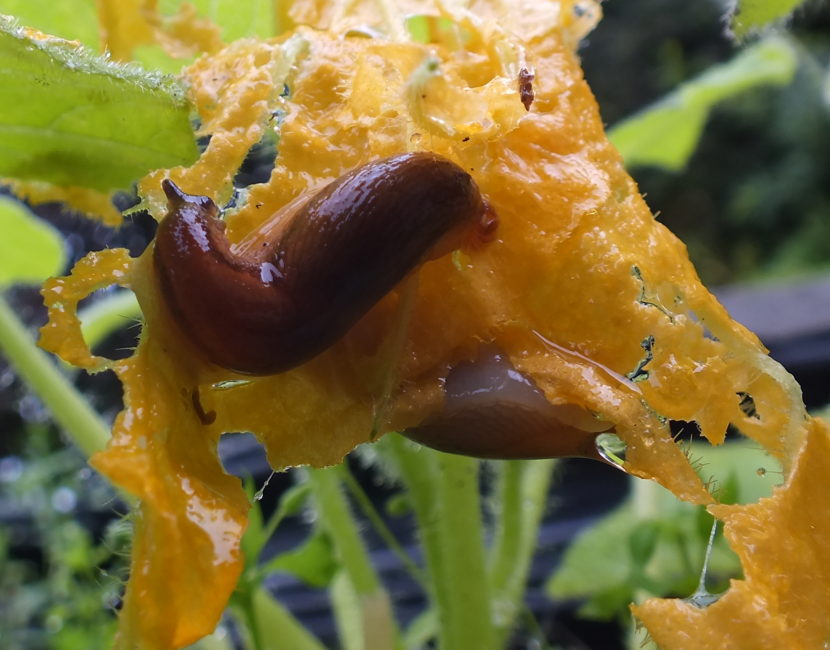
With all the rain this past week, fear of landslides and flooding has been at the forefront of many minds in Juneau. But what about the gardens? How does one respond to too much water permeating plant roots and garden beds? Master Gardener Ed Buyarski spoke with KTOO’s Chloe Pleznac about potential problems to look for, which plants may be ready to harvest and even shares his anti-slug elixir (it’s ammonia and water).
Listen:
This transcript has been lightly edited for clarity and length.
Chloe Pleznac: With all the rain this week, should gardeners be concerned for their garden beds? I imagine with all the moisture building up, it can destabilize uncovered — and perhaps even covered — gardens.
Ed Buyarski: Yes. And I’ve certainly gotten calls about what do I do? Do I need to pull out my garlic? I’m worried about my potatoes rotting in the ground. Again, this pushes us to go outside to see that our soil is draining well or that we may need to work on digging ditches. That’s assuming that you have a place to drain the water off safely, without draining it onto your neighbor’s property, which gets ugly. But looking at your own, you may need to add some more sand to your garden soil compost mixture. You may need to put up some hoops in plastic to keep things warmer and drier. All that helps.
Chloe Pleznac: Concerning root rot or other symptoms of all of this wetness, what kind of things should gardeners be looking for?
Ed Buyarski: Yes, so certainly just I mean, mold and mildew are always with us. Last summer in July, it was nice and dry. It was wonderful. Things were big, beautiful, healthy. And this year, I mean, rain has beaten down the plants. There’s some of that extra fungus and mold and mildew happening. We need to be aware of that. Depending on the plants, I mean, lettuce does not take this heavy rain very well, though the slugs like it a lot. So what we can do, is raise beds and create raised boxes, that is important for warming our soil and drying out our soil. Again, making sure there’s enough good drainage is good, you don’t have pools out there, or you don’t have your plants in your garden in a low spot in your yard. So again, making some ground higher or if you can move — I mean, literally move — your beds.
Chloe Pleznac: Aside from the weather, it’s now mid-July. What plants are you beginning to harvest in your own garden and for maybe the less experienced gardener — perhaps this is their first year — how can you tell when certain veggies are ready to harvest?
Ed Buyarski: Garlic has several indicators of when it is ready to be harvested, I’ve already harvested our scapes. So, the scapes curl when they first come out and then they uncurl and when the tips are pointing straight up, that’s one indicator that the bulbs are mature enough. I’d also like to see four green leaves still on the top of the plant, the lower leaves will start to turn yellow and or, if we’re lucky dry off or turn brown. But with four green leaves on top. That means there are at least two layers of skin covering the garlic bulb underground, which we want for long-term storage when we carefully dig them up. Don’t pull them up by hand as if your garlic is well anchored, you may break them off at the soil level. Use a garden fork to loosen them. Pull them up gently, brush the soil off, and find a dry, hopefully warm, spot. I’ve used a dehumidifier to help dry out the garlic so that it will store properly for weeks or months or longer. I’ve got one or two bulbs left from last year. With potatoes, looking at the plant again will tell us. Right now, mine are flowering which means little potatoes are forming underground. And because they’ve grown rather well and the rain has hit them, they’ve kind of flopped down on the garden boxes and beds. That’s okay. They’ll keep growing sometimes you’ll get three to four to five-foot-long potato vines. But when the potato vines and leaves start to turn yellow, most likely in September, maybe late August, and maybe even later than that depending on when you planted yours. Or, if we get a frost, the frost will usually kill off the potato plants. And so that is time to know after that to harvest.
Oh! And get out there with the ammonia and water spray and start thinning out the herds of slugs, which are just dancing in the streets or, in this case, the gardens.

